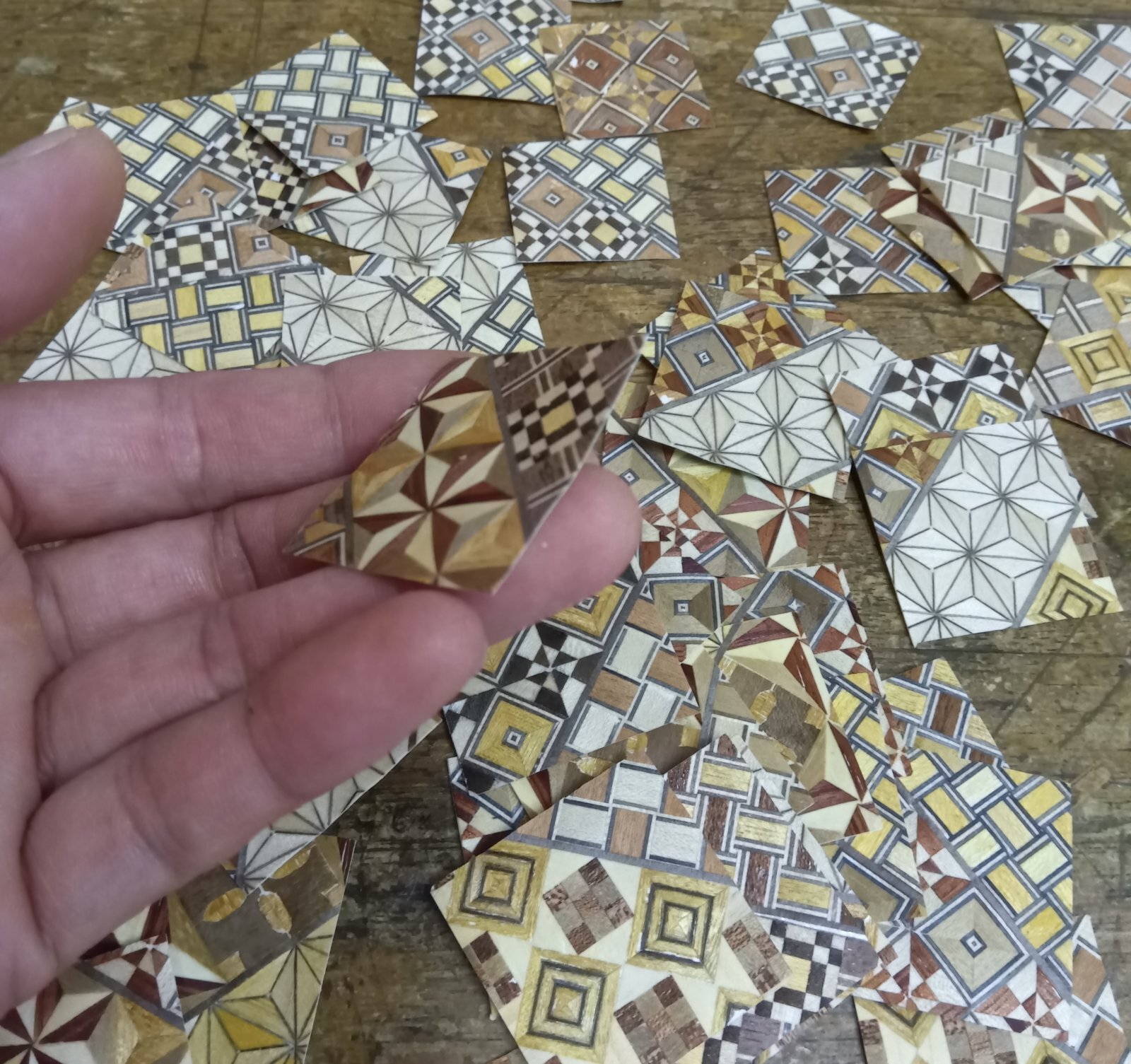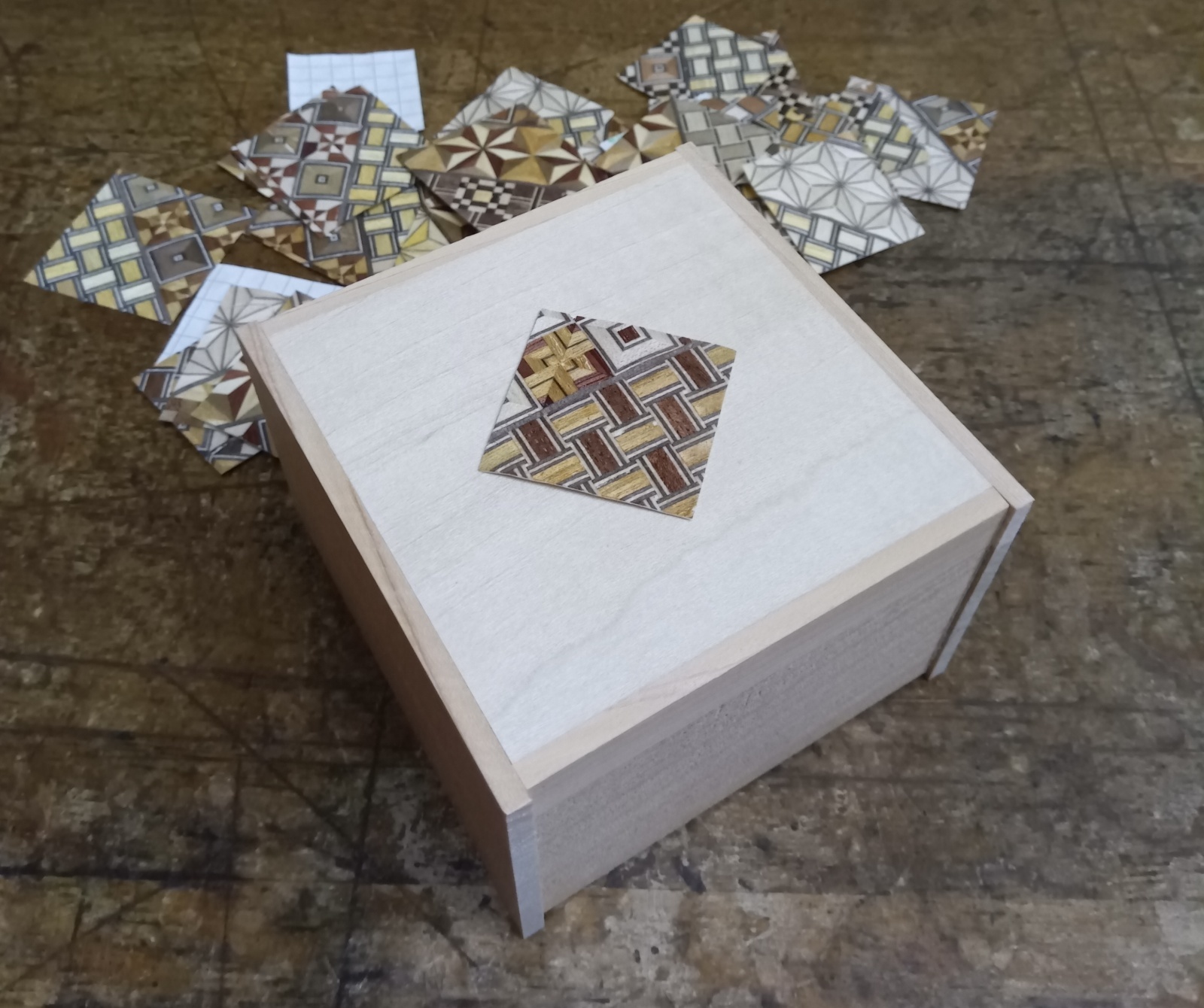One-point yosegi boxes
As my next project, I will begin working on a 3-sun 12-step Himitsubako. Although I say 'begin,' as I mentioned in a previous post, the structural components of the box are already complete, and all that remains is to attach the outer panels. In other words, the top and bottom panels, the side panels, and the panels for the aruki.
This 3-sun 12-step Himitsubako will consist of about 50 boxes in total. Half of them will feature a combination design of traditional yosegi and walnut wood, while the other half will have a combination design of one-point yosegi and checkered pattern (Ichimatsu). The photo shows the yosegi sheet for the one-point design before being pasted.
When I saw this yosegi sheet, an idea came to me. I decided to use this one-point yosegi design for the square-shaped Himitsubako that are currently being made. Until now, I’ve only used the one-point yosegi on standard 3-sun and 4-sun boxes, so I thought it would be nice to apply it to the square boxes as well. Since the one-point yosegi places a square yosegi sheet exactly in the center, I believe it would suit the symmetrical design of the square box. Additionally, I have some extra yosegi sheets for the one-point design this time, so I can use those. The photo shows the yosegi sheet placed on top of the square box before it has been attached.
When I first made the one-point yosegi box, it was designed as a slightly lower-priced box to help introduce Himitsubako to more people. However, contrary to my initial thoughts, while the amount of yosegi-zaiku on the exterior of the box was minimal, which helped reduce costs, the internal structure of the puzzle box was the same as the standard products, meaning the production effort was nearly the same. As a result, I couldn't sell it for much cheaper. Still, I plan to offer it this time at a 'slightly' lower price than the regular yosegi or solid wood square boxes. So, while the price will be somewhat lower, rest assured that the 'movement' and 'quality' of the Himitsubako are the same as the standard boxes!😁
This 3-sun 12-step Himitsubako will consist of about 50 boxes in total. Half of them will feature a combination design of traditional yosegi and walnut wood, while the other half will have a combination design of one-point yosegi and checkered pattern (Ichimatsu). The photo shows the yosegi sheet for the one-point design before being pasted.
When I saw this yosegi sheet, an idea came to me. I decided to use this one-point yosegi design for the square-shaped Himitsubako that are currently being made. Until now, I’ve only used the one-point yosegi on standard 3-sun and 4-sun boxes, so I thought it would be nice to apply it to the square boxes as well. Since the one-point yosegi places a square yosegi sheet exactly in the center, I believe it would suit the symmetrical design of the square box. Additionally, I have some extra yosegi sheets for the one-point design this time, so I can use those. The photo shows the yosegi sheet placed on top of the square box before it has been attached.
When I first made the one-point yosegi box, it was designed as a slightly lower-priced box to help introduce Himitsubako to more people. However, contrary to my initial thoughts, while the amount of yosegi-zaiku on the exterior of the box was minimal, which helped reduce costs, the internal structure of the puzzle box was the same as the standard products, meaning the production effort was nearly the same. As a result, I couldn't sell it for much cheaper. Still, I plan to offer it this time at a 'slightly' lower price than the regular yosegi or solid wood square boxes. So, while the price will be somewhat lower, rest assured that the 'movement' and 'quality' of the Himitsubako are the same as the standard boxes!😁

